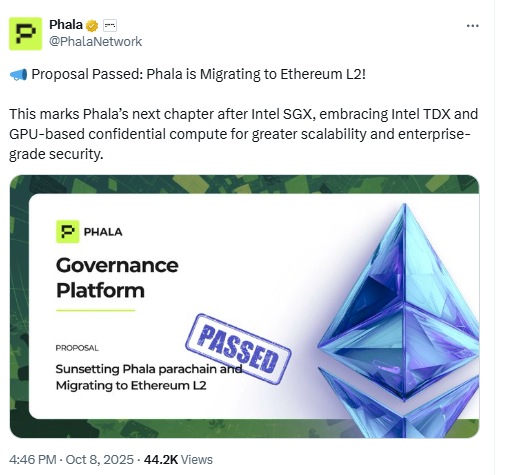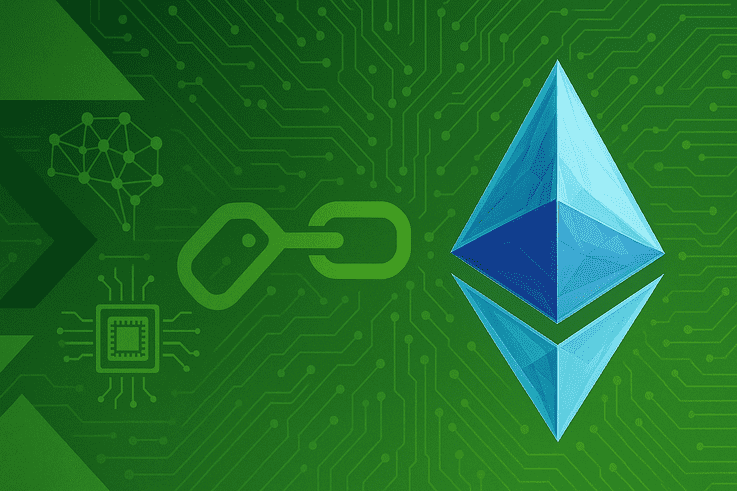Phala approved a full migration from the Polkadot parachain to its Ethereum L2. The team set the start before November 20.
PHA token holders will receive a 1:1 ERC-20 swap. Staking, rewards, and governance will continue on the Ethereum L2.
Ethereum L2 Migration: Timeline, PHA Token Swap, and Continuity
Phala confirmed the vote in an X post on Wednesday. The message read, “Proposal Passed: Phala is Migrating to Ethereum L2!” The announcement placed the migration window before November 20.

The PHA token will convert to a new ERC-20 at a 1:1 ratio. The team states that existing balances will map to the Ethereum L2 token. The swap keeps supply and denominations consistent for holders.
Staking, rewards, and governance will proceed on the Ethereum L2 after the move. Users can expect continuous participation. The plan focuses on keeping on-chain roles available during the migration.
Phala already runs a “live and functional” Ethereum L2 that launched in January. The current decision shifts full attention to that stack. The Polkadot parachain will no longer be the primary home for PHA.
Why Phala Leaves Polkadot Parachain for Ethereum L2: Scale, EVM, Liquidity
The proposal was submitted on September 27 by doylegxd, Phala Network’s ecosystem success lead.
It recommended consolidating staking, governance, and confidential compute within an EVM-aligned ecosystem. The goal was to centralize activity on one toolset.
The document argued that renewing a Polkadot parachain slot would mean “infrastructure with limited scalability.” It also pointed to maintenance demands. Those demands would absorb resources without improving the compute footprint.
The text emphasized standard tooling and liquidity on Ethereum. It cited compatibility with wallets, oracles, and developer pipelines. The Ethereum L2 path places Phala next to established liquidity and EVM infrastructure.
Confidential AI Compute and GPU Compute on Ethereum L2: TDX and Enterprise Workloads
Phala describes itself as a decentralized cloud for private, secure, and scalable computation. It targets AI-integrated Web3 applications that need confidentiality. It uses trusted execution and hardware-grade privacy for sensitive tasks.
The proposal states,
“L2 offers lower operational overhead and direct integration with Ethereum liquidity and tooling. It is also the natural home for deploying TDX and GPU-based confidential compute workloads, where we already see early-stage commercial traction.”
The quote underscores the AI compute and GPU compute focus.
This Ethereum L2 design keeps confidential AI compute close to capital and developer tools. It also positions TDX and GPU compute workflows near EVM standards. Enterprise users can align compute, liquidity, and governance on one chain.
Market Context: Phala, PHA Token Metrics, and Multichain Comparisons
Phala secured a Polkadot parachain slot in late 2021. That placement put the network among early Polkadot auction winners. The new Ethereum L2 move shifts the network’s core execution layer.
Other Polkadot projects took different routes. Astar and KILT Protocol integrated Ethereum through a multichain approach.
They kept Polkadot parachain operations while adding EVM paths. Phala instead chose a full migration to the Ethereum L2.
The PHA token sits eleventh among AI-agent crypto assets by market capitalization at $80.6 million, per CoinGecko.
It also ranks within the top 50 AI tokens by market cap. These figures place PHA inside an active AI compute segment.
Governance and Dates: September 27 Proposal, Vote, and Before November 20 Start
The proposal date was September 27. The community advanced it quickly after public discussion. The X confirmation followed with the migration window set before November 20.
The team reiterated continuity for staking, rewards, and governance on the Ethereum L2. The ERC-20 mapping preserves balances at a 1:1 ratio. That design limits friction for PHA token holders.
Next steps will cover exact swap procedures and Ethereum L2 participation specifics. The project will communicate checkpoints and final timings. The focus remains on a smooth migration to the EVM environment.
Disclosure:This article does not contain investment advice or recommendations. Every investment and trading move involves risk, and readers should conduct their own research when making a decision.
Kriptoworld.com accepts no liability for any errors in the articles or for any financial loss resulting from incorrect information.

Tatevik Avetisyan is an editor at Kriptoworld who covers emerging crypto trends, blockchain innovation, and altcoin developments. She is passionate about breaking down complex stories for a global audience and making digital finance more accessible.
📅 Published: October 10, 2025 • 🕓 Last updated: October 10, 2025


